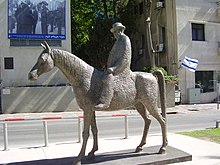Meir Dizengoff

Meir Dizengoff ( Hebrew מאיר דיזנגוף, Russian Меер Янкелевич Дизенгоф ; also: Meir Diesengoff ; born on February 25, 1861 in Yakimovichi (today Echimăuți ) in Bessarabia ; died on September 23, 1936 in Tel Aviv ) was an engineer and businessman and co-founder and first and long-standing mayor of Tel Aviv.
Life
Dizengoff served in the Russian army in Zhytomyr and was promoted to officer. During this time he met his future wife Zina-Haya Brenner. Because of his participation in the anti-Tsarist underground movement Narodnaya Volja , he was imprisoned for eight months in 1885, after which he turned to Chibbat Zion , a predecessor of Zionism , and from 1887 studied chemical engineering at the Sorbonne in Paris. In 1892 he founded a but unsuccessful glass factory financed by Baron Rothschild in Tantura in Palestine . After his marriage to Zina-Haya Brenner in Alexandria in 1893, he returned to Russia in 1894 and became an advocate of Zionism in Odessa after Theodor Herzl's appearance . As a delegate of the Zionists there, he traveled to the 6th Zionist Congress in Basel in 1903 , where he spoke out against the proposal to found a Jewish state in Uganda . In 1904 he founded a land purchase company for Palestine called the Geulah Company in Odessa.
On behalf of the Geulah Company, Dizengoff was again in Palestine in 1905, but also worked as a private merchant for his own company Dizengoff & Co. , which was active in the freight and import-export business. On April 11, 1909, 66 families gathered on Jaffa Beach . They had come together to draw lots to hand out lots for a new Jewish quarter outside Jaffa. The lot with the number 43 was drawn by the married couple Meir and Zina Dizengoff, who built their house on the plot that would later be their address, which will later be called Rothschild Boulevard 16 . ( Location ) At that time the new settlement was still called Achuzat Bayit and was renamed Tel Aviv by its residents in 1910. Dizengoff became chairman of the owners' committee in 1911. Over the years, the small settlement became the largest city and the cultural center of the Yishuv . Between 1931 and 1938, Tel Aviv's population rose from 46,000 to 150,000.
After Tel Aviv was declared a city in 1921, he was its mayor from 1921 (de facto as chairman of the local council since 1911) until his death (with an interruption from 1925 to 1928).
Dizengoff donated his house on Rothschild Boulevard and his entire estate to the Tel Aviv Museum he founded in 1931 (in which Israeli independence was proclaimed in 1948 ).
Since 1937 the city of Tel Aviv has awarded the “ Dizengoff Prize ”, named after its founder and first mayor, to painters and sculptors (= “The Dizengoff Prize for Painting and Sculpture”).
After Dizengoff is the Dizengoff Street , one of the largest streets of Tel Aviv, named, and after his 1930 late wife Zina one of the most famous squares of the city, in the Dizengoff Street opens. The Dizengoff Center shopping center also bears his name.
Web links
Individual evidence
- ^ Independence Hall
- ↑ Everything at the beginning. The famous Tel Aviv landmark is being returned to its old state.
| personal data | |
|---|---|
| SURNAME | Dizengoff, Meir |
| BRIEF DESCRIPTION | Mayor of Tel Aviv |
| DATE OF BIRTH | February 25, 1861 |
| PLACE OF BIRTH | Bessarabia |
| DATE OF DEATH | September 23, 1936 |
| Place of death | Tel Aviv |
